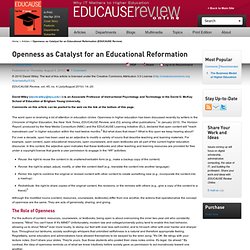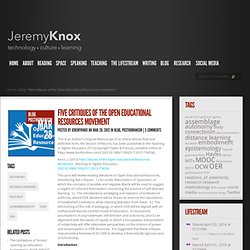

Browse: Rubric: Degree of Alignment. Free Educational Resources. Free Educational Resources. From knowledge to bathroom renovations. This site has been created to foster discussion on how our thinking, learning, and organizational activities are impacted through technology and societal changes.

Since the original publication of Connectivism: A Learning Theory for the Digital Age, I've been approached by many people requesting additional thinking and discussion. Four tools are available to provide dialogue: Blog for my personal reflective thoughtsWiki for collaborative content creationDiscussion forums for discussion on issues impacted by a connectivist view of learningEmail list for discussions on technology, networks and learning Most resources on this site are intended for public viewing, but contributing to the wiki or discussion forums requires registration. Please create your account by clicking the "join" text on the top, right-hand corner. If you are interested in general learning and technology trends, please visit my elearnspace site.
Openness as Catalyst for an Educational Reformation (EDUCAUSE Review. © 2010 David Wiley.

The text of this article is licensed under the Creative Commons Attribution 3.0 License ( EDUCAUSE Review, vol. 45, no. 4 (July/August 2010): 14–20 David Wiley (david.wiley@byu.edu) is an Associate Professor of Instructional Psychology and Technology in the David O. McKay School of Education at Brigham Young University.
Comments on this article can be posted to the web via the link at the bottom of this page. The word open is receiving a lot of attention in education circles. For over a decade, open has been used as an adjective to modify a variety of nouns that describe teaching and learning materials. Although the modified nouns (content, resources, courseware, textbooks) differ from one another, the actions that operationalize the concept of openness are the same. The Role of Openness For the authors of content, resources, courseware, or textbooks, being open is about overcoming the inner two-year-old who constantly screams: "Mine!
A Lesson from History Notes.
Five critiques of the Open Educational Resources movement. This is an Author’s Original Manuscript of an article whose final and definitive form, the Version of Record, has been published in the Teaching in Higher Education 2013 [copyright Taylor & Francis], available online at: DOI:10.1080/13562517.2013.774354].

Knox, J. (2013) Five Critiques of the Open Educational Resources Movement. Teaching in Higher Education, DOI:10.1080/13562517.2013.774354 This post will review existing literature on Open Educational Resources, introducing five critiques: 1.) An under-theorisation of ‘openness’, in which the concepts of positive and negative liberty will be used to suggest a neglect of coherent theorisation concerning the practice of self-directed learning. 2.)
The simultaneous privileging and rejection of institutional authority, where OER literature will be shown to endorse the reputations of established institutions while claiming liberation from them. 3.) Introduction An under-theorisation of the notions of ‘openness’ and ‘freedom’. Harvard Classics. Charles William Eliot, compiler and editor of the Harvard Classics anthology.

The Harvard Classics, originally known as Dr. Eliot's Five Foot Shelf, is a 51-volume anthology of classic works from world literature, compiled and edited by Harvard University president Charles W. Eliot and first published in 1909.[1] Eliot had stated in speeches that the elements of a liberal education could be obtained by spending 15 minutes a day reading from a collection of books that could fit on a five-foot shelf. (Originally he had said a three-foot shelf.) Eliot worked for one year with William A. Contents[edit] The Harvard Classics Shelf of Fiction[edit] The Harvard Classics Shelf of Fiction was selected by Charles W.